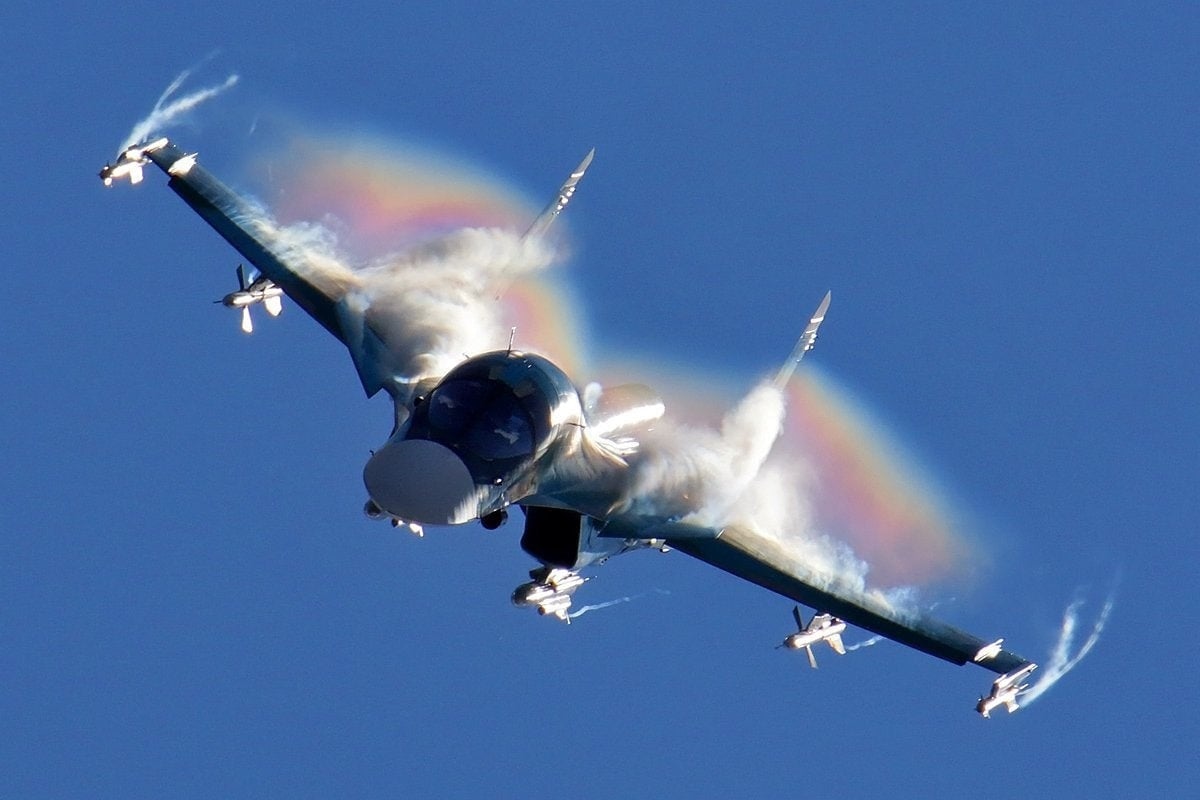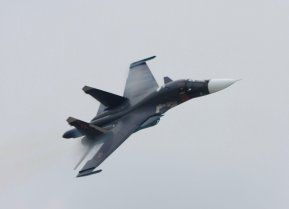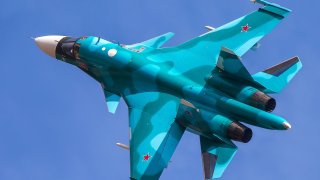Su-34: Russia's Badass Fighter-Bomber Has a Problem
The Su-34 is powered by a pair of Saturn AL-31FM1 turbofan engines, the same engines used on the Su-27SM, giving the aircraft a maximum speed of Mach 1.8+ when fully loaded. Nonetheless, it still has seen losses in the Ukraine war.
Russia Lost Three Su-34s in a Single Day in Ukraine - Since the Kremlin launched its unprovoked invasion of Ukraine nearly two years ago, Moscow has confirmed the loss of at least ten Sukhoi Su-34 (NATO reporting name "Fullback") multirole strike aircraft. The twin-engine, twin-seat, all-weather supersonic medium-range fighter-bomber was developed initially for the Soviet Air Forces, and it entered service with the Russian military in 2014.

Ukraine's air force announced on Friday that it had shot down three Russian Sukhoi Su-34 fighter-bombers in the south of the country, with President Volodymyr Zelenskyy stating it had happened in the Kherson region where fighting continues to rage.
"At noon today, three Russian Su-34 fighter-bombers were shot down in the southern operational zone," the commander of the Ukrainian Air Force, Mykola Oleshchuk, announced via the social messaging Telegram platform.
Su-34 - An Advanced Cold War Aircraft
Developed during the latter stages of the Cold War, the Sukhoi Su-34 was one of the Kremlin's many programs that were forced on the backburner following the dissolution of the Soviet Union and the economic crisis that followed.
The program was only revived in earnest in the early 2000s, with eight pre-production aircraft built for trials and evaluations.
It formally entered service in 2014 – although there are reports that it was employed during the Russo-Georgia War of 2008. Approximately 155 have been manufactured, including the prototypes and serial-produced aircraft. Originally designated the Su-27IB, it was based on the Sukhoi Su-27 (NATO reporting name "Flanker"), and was developed primarily for a strike/attack role to replace the Su-24 (NATO reporting name "Fencer") attack fighter and Tupolev Tu-22 (NATO reporting name "Blinder") bomber with a single platform.
The Su-34's surface design includes a duckbill-shaped nose cone, two tail fins broadly reminiscent of the Su-27, canards to assist with maneuverability, and a side-by-side cockpit that can potentially facilitate improved communication between the two pilots.
It really wouldn't be an overstatement to suggest that the Su-34 was one of the best aircraft to come out of the Soviet Union during the late Cold War period. As EuroNews.com reported, the Su-34 has been touted as Russia's most advanced twin-seat supersonic medium-range fighter-bomber — a type of combat aircraft not commonly found in Western arsenals, with the U.S.-made F-111 and F-15E Strike Eagle being the most similar multirole counterparts.
The Su-34 has been employed on missions in Syria and Ukraine.
"Despite the Kremlin touting it as the crown jewel of its military aviation, Su-34s have been used in low-altitude bombing attacks due to a lack of guided missiles, exposing them to heavy air defences," EuroNews further noted.
Speedy and Well-Armed Warbird
The Su-34 is powered by a pair of Saturn AL-31FM1 turbofan engines, the same engines used on the Su-27SM, giving the aircraft a maximum speed of Mach 1.8+ when fully loaded. When equipped with a full weapons load, the Su-34 has a maximum range of 4,000 km (2,500 mi; 2,200 nmi), or further with aerial refueling. It is further equipped with counter-fire and electronic warfare (EW) counter-measures systems.
The fighter-bomber features a modern glass cockpit, with color multi-function displays, while its nose section accommodates a suite of advanced multi-mode phased array radar, capable of terrain following. The cockpit and some other crucial components and systems are reported to be armored, and the Su-34 is fitted with comprehensive electronic countermeasures equipment. The Su-34 further has a rearward facing radar and can launch air-to-air missiles at pursuing enemy aircraft.
The Su-34 typically carries 4,000 kg of weapons, while the maximum capacity is 8,000 kg. Its primary air-to-air weapon is the R-77 (AA-12) missile, with two R-73 (AA-11 or Archer) short-range air-to-air missiles carried on wingtip rails. For ground and naval strike roles, the Russian fighter-bomber can be armed with long-range standoff weapons, including the Kh-55, Kh-59, Kh-59M, Kh-25, Kh-29 air-to-surface missiles, Kh-31, Kh-35, Kh-41 Moskit, and P-800 Oniks anti-ship missiles, and Kh-58 anti-radiation missiles.
It is armed with a 30 mm GSh-301 cannon with 180 rounds, and the aircraft is equipped with 10 underwing and under-fuselage hardpoints for a wide range of weapons, including air-to-air, air-to-surface, anti-ship and anti-radiation missiles, guided or free-fall bombs.
Two-Dozen Lost?
Though Moscow has confirmed that around 10 have been lost in combat, the tally of destroyed Su-34s may be much higher. As of this past May, there have been 20 visually confirmed cases of Su-34s being lost, damaged or abandoned by Russian forces, according to the open-source intelligence site Oryx.
The first was lost just days after Moscow launched its unprovoked invasion in February 2022..
The Kremlin has not commented on the reported loss of the three jets, but military analysts and war bloggers have speculated the aircraft were targeted and destroyed by U.S.-made Patriot missiles. Those air defense weapons, which were supplied to Kyiv earlier this year, are proving to have been an early Christmas present.
Author Experience and Expertise
Peter Suciu is a Michigan-based writer. He has contributed to more than four dozen magazines, newspapers, and websites with over 3,200 published pieces over a twenty-year career in journalism. He regularly writes about military hardware, firearms history, cybersecurity, politics, and international affairs. Peter is also a Contributing Writer for Forbes and Clearance Jobs. You can follow him on Twitter: @PeterSuciu.


